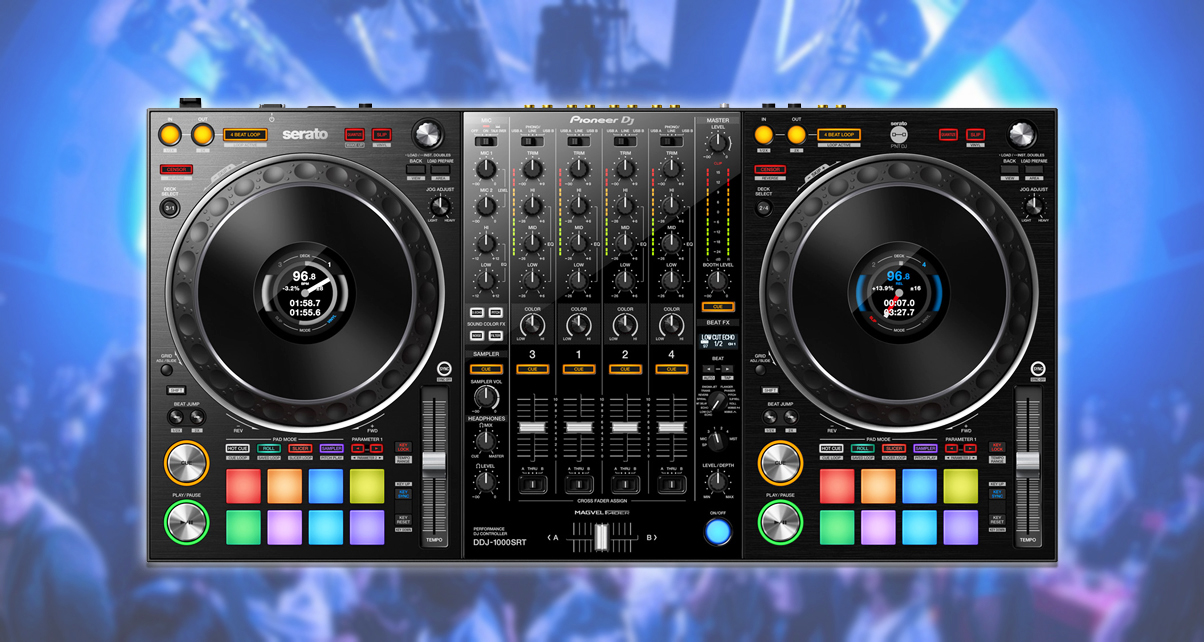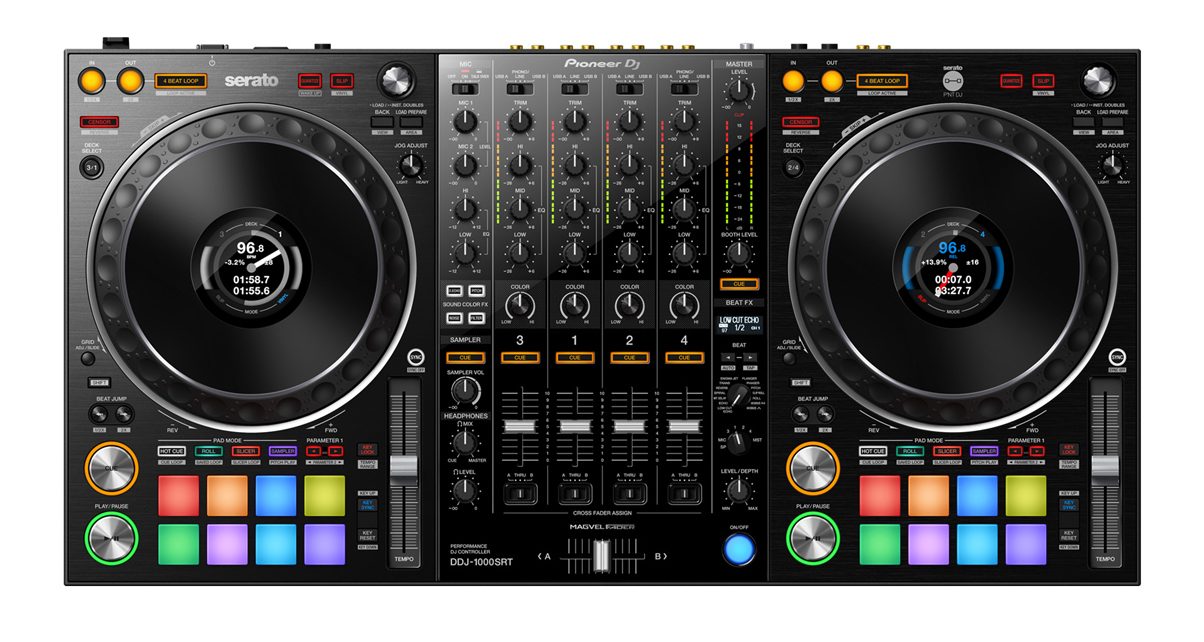The Lowdown
The DDJ-1000SRT is a four-channel device for Serato DJ Pro that packs the club standard CDJ/DJM layout into a controller. Its biggest feature are the full-sized CDJ-style mechanical jogwheels that have onboard displays that show track info like BPM, time elapsed and time remaining, though you don’t get crucial data like waveforms. Despite that, it’s still a great controller for DJs who want the closest thing to a club set-up. If you’re a Serato DJ user and you’ve been jealous of your Rekordbox DJ friends spinning with a DDJ-1000, your prayers have been answered.
Don’t have our latest DJ gear guide? Click here to grab your free copy
Video Review
First Impressions / Setting up
The DDJ-1000SRT is a four-channel controller that’s got two CDJ-style jogwheels with onboard displays, eight performance pads per deck, eight performance pad modes (more on those later), long-throw pitch faders with Sync, Key Sync, Key Lock and Key Lock (Master Tempo) buttons, deck select buttons for toggling between decks 1/3 and decks 2/4 in Serato DJ Pro, Censor buttons for bleeping out naughty words on the fly, and browse and load buttons per deck. You also get CDJ-style looping controls and a Jog Adjust tension knob.
The mixer consists of four channels that have three-band EQs, trim pots, Sound Color knobs, volume faders, input selection switches (phono, line, USB-A and USB-B) and a Magvel crossfader with crossfader assign switches per channel. You get master and booth output knobs, two microphone channel knobs with an on/off/talkover switch and two-channel EQ, headphone volume and cue mix knobs, and a sampler volume knob.
It has Pioneer DJ’s Sound Color FX on the left side of the mixer, and Beat FX on the right, both of which are found in DJM mixers used in clubs.

Round the back you’ll find a Kensington Lock, XLR and RCA master outputs, 1/4” booth outputs, a grounding post for turntables, four pairs of RCA line inputs for connecting media players, with two of them being switchable phono inputs for connecting turntables. You also get two USB jacks for hooking up to two laptops (for quick DJ switchovers), omni and 1/4″ mic jacks, a power switch, and a power socket for connecting the included power brick. In front are 1/4″ and 1/8″ headphone jacks.
DJ like a pro using ANY gear: The Complete DJ Course
The DDJ-1000SRT comes with a licence for Serato DJ Pro, and you also get Serato DVS should you wish to spin with timecode vinyl or CDs. The first 5000 buyers get a full Serato Suite licence that gets you everything Serato has to offer, including all the effects, Serato Video, and more.
In Use
Full-sized CDJ-style jogwheels

The DDJ-1000SRT has full-sized mechanical jogwheels similar to what you’d find on a CDJ. If you’ve only ever used DJ controllers in the past, the difference is that you need to press down on the top of these jogwheels (the top acts as a plate) for it to register as you “holding down” on the jog. This is in contrast to other DJ controllers that have touch-capacitive jogs, meaning you’re able to “hold down” on a track just by applying even a tiny bit of pressure. If you’re training yourself to get used to spinning with CDJs (one of the main reasons DJs will want to buy this), this is a great controller to practise on.
The jogwheels also have the Jog Adjust knob that lets you dial in the tension of the jogwheel: clockwise makes the jog stiffer, and anti-clockwise makes it looser. I like my jogwheels stiff so I keep them at the three o’clock setting, but for spinbacks I like them pretty loose, so it’s cool that you have the Jog Adjust onboard.
These full-sized jogs are the main selling point of the DDJ-1000SRT. Other DJs may scoff at such a big device, since DJ controllers originally were prized for their compact footprint and portability (at least until the DDJ-SX came along) but that was a long time ago. Today’s DJ controllers come in all shapes and sizes, and you even have behemoth devices like the Numark NS7III and Pioneer DJ DDJ-RZX that can do everything a CDJ does and a whole lot more. The DDJ-1000SRT isn’t quite as large as these controllers, but it’s still a sizeable unit.
Jogwheel display

Another big come on for the DDJ-1000SRT are the displays found at the centre of the jogwheels. They are meant to keep you from having to look at your laptop screen so often (is that really a bad thing these days?) and they do that by showing track data: you’re able to view a loaded track’s BPM, time elapsed, time remaining, and needle position. The displays look like the deck displays in Serato DJ Pro. This is all well and good, but it’s missing two crucial bits of data that were present in the original DDJ-1000: track waveforms and album art.
The DDJ-1000’s displays are effective at making you look at your laptop less because not only are you able to see a track’s waveform, but you can also configure it to display the Cue Scope which shows you hot cues and cue / loop points in the track. You also aren’t able to view album art, which is an aesthetic thing but something that DJs still like to see. Granted, Serato DJ Pro’s decks don’t show any album art at all (you only see them in your browser if you enable them) but it would still have been a nice touch to see them on the jog display.
Read this next: 5 Settings You Haven’t Touched On Your DJ Gear (But Maybe Should)
The absence of both of these in the DDJ-1000SRT’s screens make them feel a bit watered down as a result. Certainly not a dealbreaker, but it makes the screens feel like something from a previous generation (eg Numark NS6II) instead of cutting edge. Hopefully a firmware or software update in the future can rectify this, but at the time of this writing, that is all you’re going to get with the displays.
Sound Color FX

The DDJ-1000SRT comes with Pioneer DJ’s Sound Color FX found to the left of the mixer, and there are four that you can select from: Dub Echo, Pitch, Noise and Filter. Choosing an effect is as simple as pressing the corresponding Sound Color FX button, and then turning the knob of the channel you want effected clockwise or anti-clockwise which gives a different effect response.
On the DDJ-1000, these Sound Color FX are configurable within Rekordbox DJ, letting you swap out and customise them by choosing from the other available Sound Color FX (there are eight in total). You can’t do that with the DDJ-1000SRT.
Beat FX

There is a full complement of Beat FX on the DDJ-1000SRT, which is found to the right of the mixer. Beat FX is the effects strip found in DJM-style club mixers, and it gives you more creative effects control because you can set the beat length of your chosen effect, which gives you different harmonic flavours. There are 14 Beat FX in total: Low Cut Echo, Echo, MT Delay, Spiral, Reverb, Transformer, Enigma Jet, Flanger, Phase, Pitch, Slip Roll, Roll, Mobius Saw and Mobius Triangle. It’s exactly the same set of effects found on the original DDJ-1000.
The way it works is you use the Beat FX selector knob to pick an effect, then you pick which channel you want to assign that effect to (Sampler, Mic, channels 1, 2, 3 or 4, and Master), then you press the on/off button at the bottom of the Beat FX strip. You can also adjust the amount of the Beat FX applied via the Wet/Dry knob.
Performance pads

The DDJ-1000SRT has eight performance pads with eight performance pad modes that will be familiar to Serato DJ users: Hot Cue, Roll, Slicer, Sampler, Cue Loop, Saved Loop, Slicer Loop and Pitch Play. It also has Parameter buttons for scrolling through pad mode pages in Serato DJ Pro.
Get the course: Serato Made Easy
One thing that I do miss on this controller is the ability to use Serato DJ Pro’s built-in effects. With past Pioneer DJ controllers (eg DDJ-SX3, DDJ-SR) you had FX sections at the top of both decks consisting of buttons and knobs that let you tweak Serato’s effects. But since those FX sections have been replaced by CDJ-style looping controls, there’s no way for you to mess with them anymore unless you do some Midi mapping.
Pioneer DJ probably assumes you’d rather use the Sound Color FX and Beat FX, but longtime Serato DJ users will miss their FX chains. The original DDJ-1000 had Pad FX pad modes that let you trigger Rekordbox DJ’s built-in effects, and it would’ve been cool if the DDJ-1000SRT had it too by default.
Conclusion

The DDJ-1000SRT is a solid choice for Serato DJs who want a device that will make the transition from controller to CDJ/DJM set-up smoother, and it certainly ticks a lot of mobile and pro DJ boxes too (eg dual mic inputs and booth outputs). But having used the DDJ-1000 extensively with Rekordbox DJ, I can’t help but feel that the controller was a bit shoehorned to make it work with Serato DJ Pro, which led to a few features being left out. The most obvious being the fewer data points found in the onscreen displays, which slightly diminish the allure of having onboard screens. But to be honest, even with the original DDJ-1000, I still find myself looking at my laptop screen a lot, so no this isn’t a dealbreaker in my book.
A 1:1 port of the DDJ-1000 would’ve been ideal, but this is still a solid controller that will sell by the bucketload because there isn’t a Serato controller out in the market that can get you as close to a CDJ/DJM set-up as the DDJ-1000SRT can. If you’re a club / festival DJ who spins with Serato DJ and you don’t want to blow your hard earned cash on a full NXS2 system that will just act as a glorified controller, this is the controller you’ve been waiting for.
Want help choosing gear? Grab your free PDF: The Digital DJ Gear Buyer’s Guide




